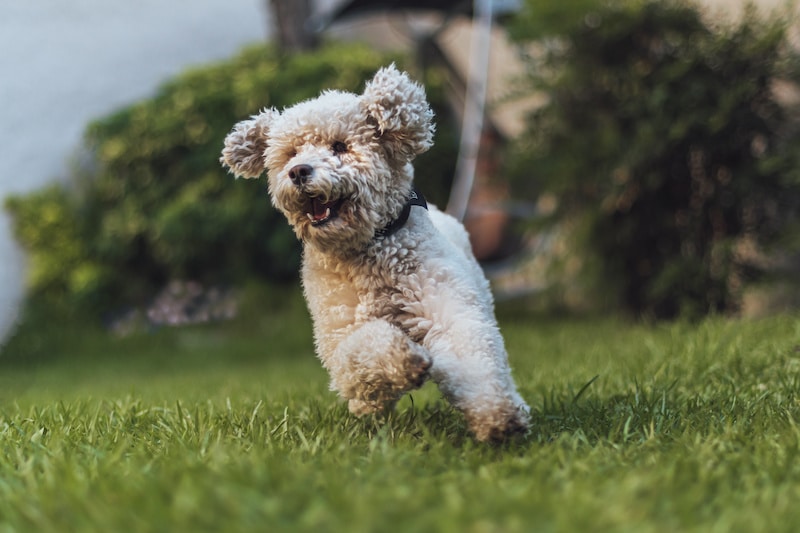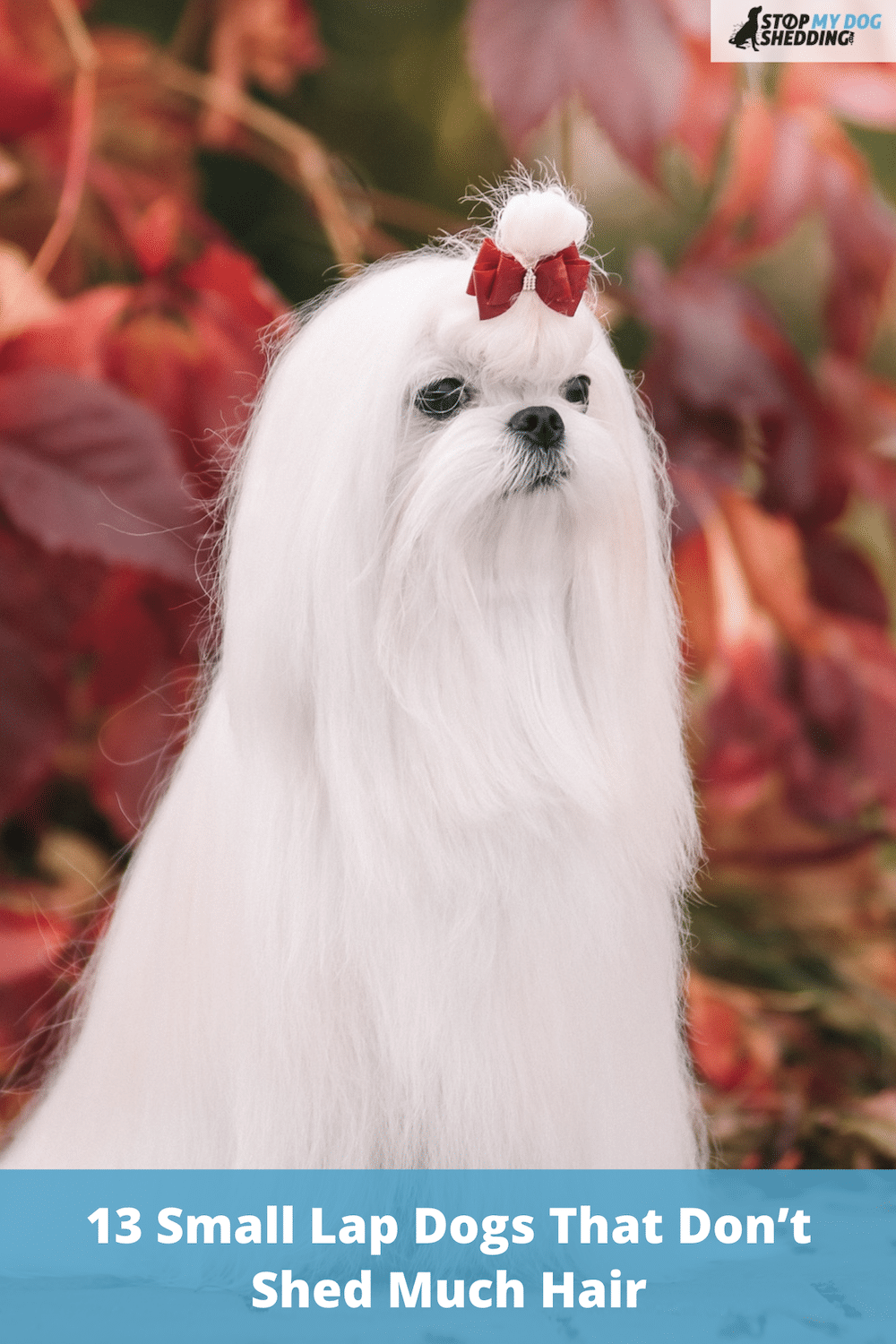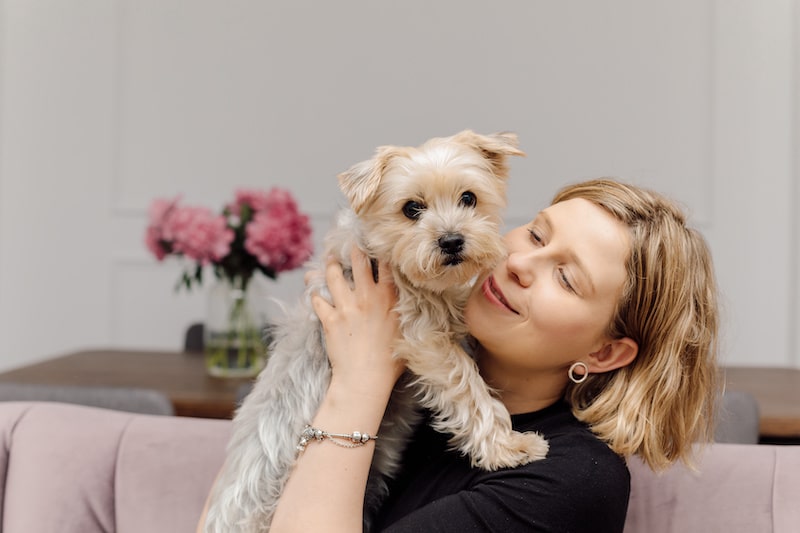Lapdogs are among the best types of canine companions, but no one likes to stand up after a cutesy cuddle session with hair-covered clothes.
So, if you’d like a lap dog that doesn’t shed, what are your options?
Here’s the list:
- Havanese
- Chihuahua
- Miniature Pinscher
- Bolognese Dog
- Shih-Tzu
- Toy Poodle
- Chinese Crested Dog
- Brussels Griffon
- Affenpinscher
- Maltese
- Silky Terrier
- Yorkshire Terrier
- Papillon
Every dog sheds to a degree, but the combination of these breeds’ respective tiny sizes and low shedding habits make their hair drop an almost nonexistent issue. Keep reading for more information on these cuddly canine companions!
Recommended: Go here to see our top-rated dog hair blow dryers
1. Havanese

The American Kennel Club put together a list of the most hypoallergenic dogs. To be hypoallergenic means a breed doesn’t shed much. The Havanese dog breed is, according to the AKC, one of the top hypoallergenic breeds.
Adorable, smart, playful, and tiny (weighing 9 to 16 pounds), the Havanese is probably the ideal lap dog.
Its white fur won’t come off much due to the long hair growing time. Dogs grow fur in four stages, and the greater the delay between the phases, the longer it takes for the hair to shed.
The only downside is that grooming this cutesy breed is not the easiest. Despite the low shedding, the Havanese is technically a double-coated breed, so that’s twice the fur to maintain.
I recommend a pin brush for tidying your Havanese. A slicker brush is another suitable choice. Brush this dog a few times per week and bathe your Havanese at least once a month to keep that smooth white coat pristine! Check out our top-rated dog brushes for more info.
2. Chihuahua

Weighing no more than 6 pounds, a Chihuahua is certainly a lap dog if I’ve ever seen one.
I should take this moment to note that not all Chihuahua dogs are the same. You’re probably familiar with the short-haired Chihuahua, but the opposite version of this breed is the long-haired Chihuahua.
Whether you prefer your Chis with longer fur or a tidier, cropped coat, this breed is about as low-shedding as it gets.
The Chihuahua may have a double coat, which will lead to seasonal molting, but the breed’s size precludes its shed hair from requiring a ton of cleanup.
A cropped Chi doesn’t need a lot of maintenance, but if you like your Chihuahuas with a longer coat, then you’re in for more work.
The dog’s fur can be flat or wavy but will have feathering near the feet, legs, and ears. I recommend a slicker brush for these Chis especially. You can use a bristle brush for a standard short-furred Chihuahua.
3. Miniature Pinscher

The Miniature Pinscher or Min Pin is friendly, outgoing, playful, and clever. The breed also weighs no more than 11 pounds, so a lap dog the Min Pin certainly is!
If you’ve been waiting for a low-shedding small dog that’s also not a pain to groom, you’ve found it in the Miniature Pinscher.
Use a bristle brush on its coat about weekly to tame its very short fur. Bathe your Min Pin when the dog starts to stink, and you can count its grooming work as being done.
As for shedding, the Min Pin is a low shedder due to the aforementioned short coat. This breed sheds about as much as a short-haired Chihuahua, which is to say not a lot at all!
4. Bolognese Dog

The Italian Bolognese Dog made it onto the AKC’s list of hypoallergenic dogs, which tells you enough about its shedding habits. Few dogs shed as little as this one except for maybe the Havanese.
That makes the Bolognese Dog one very desirable lap pup!
So too does its docile, reserved, and loyal nature. Your dog won’t get spooked by every little sound while you two curl up to watch the latest Netflix movie or read a good book.
Maybe keep that book short, as you will have to dedicate a good chunk of time to maintaining the Bolognese Dog’s coat. The texture of this breed’s fur can be woolly and fluffy, which means tangles can become an issue without regular maintenance.
With a pin brush, comb your Bolognese Dog’s fur at least several times per week but ideally every day to every other day.
Recommended: Go here to see our top-rated dog hair blow dryers
5. Shih-Tzu

The dignified, beautiful Shih-Tzu will happily sit with you, as this is only a moderately active dog.
The breed is also highly affectionate and a little bit spunky, so you’d have a dog with a big personality despite its small size!
In the same vein as the Bolognese Dog, grooming a Shih-Tzu is admittedly a challenge. They too have a long coat that can get dirty and tangled, so get into the habit of brushing your pup about daily with a slicker brush or pin brush.
Keep your mostly white dog clean with monthly baths too.
What about the shedding habits of the Shih-Tzu? This double-coated dog can lose some of its fur in noticeable amounts, especially if you keep the dog’s coat cropped.
If you grow out your Shih-Tzu’s coat to gorgeous proportions, then the long fur catches more of the dead hair. Plus, the hair growth cycle is extended, which results in less shedding!
Recommended: Go here to see our top-rated dog hair blow dryers
6. Toy Poodle

Poodles come in all sizes, but the Toy Poodle will be more up your alley.
This small Poodle weighs 6 to 9 pounds with an average height of 10 inches. Plus, with that wiry coat, you’ll want to pet the Poodle all day!
If you read this blog regularly enough, then you may recall that wiry-coated dogs are among the lowest-shedding. That’s why the Poodle sheds so minimally, even if it’s a standard size.
Wiry coats can be a bit of a double-edged sword, though. Grooming the curls of a Toy Poodle’s coat can prove challenging.
Even once you detangle the Poodle’s fur, you next have to decide how you want to style its coat. You can select from the interesting Jacket and Pants style, the cool Lion cut, the stylish Continental cut, or the timeless English Saddler cut, among others.
Each cut requires time and dedication to get it right, as well as a further time commitment to maintain the coat length once your Toy Poodle begins growing out its fur.
7. Chinese Crested Dog

I know what you’re doing to say. The Chinese Crested Dog isn’t exactly an obvious pick for a cuddly lap dog.
And indeed, you would be correct… if you’re talking about the Hairless Chinese Crested. This mostly naked dog is unique with its horse’s mane of fur and little cuffs of hair around each leg.
Then there’s the Powderpuff Chinese Crested. You won’t believe this is the same breed, but it is!
The Powderpuff looks a lot like the Havanese or Bolognese Dog in that it’s white, small, fluffy, and too cute for words.
Even if your Chinese Crested has a lot more fur than average, the double-coated Powderpuff isn’t a huge shedder since it’s small.
How you groom this dog depends very much on the type. A Powderpuff requires daily brushing but only occasional trimming.
The Hairless Chinese Crested needs less brushing but plenty of sunblock when you two venture outside together.
To protect its exposed skin in the winter, I’d suggest a hypoallergenic, oil-free moisturizer. Keep an eye out for clogged pores, as the Chinese Crested Dog can develop acne.
8. Brussels Griffon

The Brussels Griffon comes in two varieties as the Chinese Crested Dog does.
The first is the smooth-coated Brussels Griffon, aka the Petit Brabancon, and the second is the wiry-coated Brussels Griffon, including the Griffon Bruxellois and Griffon Beige.
Both dogs have coats that possess the right traits to make the Brussels Griffon low-shedding.
The smooth-coated Brussels Griffon has a short coat, but it can shed more seasonally. If you want even less shedding in your Brussels Griffon, try the Griffon Beige or Griffon Bruxellois.
Grooming the latter requires a pin brush, which you should use at least once a week. For the Petit Brabancon, I’d recommend a rubber brush. Comb your dog every day, please!
The Brussels Griffon is a sensitive, watchful, companionable dog no matter its coat length, and that makes it a fun lap buddy.
Some dog owners even call this breed the Velcro dog because he sticks to you wherever you go!
9. Affenpinscher

Do you like the shaggy look of the Brussels Griffon? Then I’d also recommend looking into the Affenpinscher, a toy breed from Germany that weighs no more than 13 pounds. This dog is described as playful, curious, and fun-loving.
The Affenpinscher’s disheveled coat looks like it would shed tons, but it doesn’t. The fur is rough, although not wiry, and the Affen has but one coat layer as well. This is all great news for you, the dog owner.
Even grooming this dog isn’t as challenging as it would seem. I’d recommend brushing your Affen at least once per week but ideally several times with a slicker brush. Finish the grooming with a metal comb.
It’s typically best to brush an Affen starting with its chest, then the chin, then the belly, and finally, comb all four legs and the spine.
Be sure to have your dog-grooming scissors ready, as you’ll have to cut the dog’s coat several times per year.
10. Maltese

Regarded as another one of the most hypoallergenic dog breeds, the Maltese is also one of the lowest-shedding.
The Maltese’s fur growth cycle is rather prolonged. When also considering the dog’s small size and its single coat, it’s no wonder that seeing puffs of fur from this dog is such an infrequent occurrence.
If your Maltese has floor-length fur, then you’ll have your work cut out for you in the grooming department. You should expect to brush the dog every single day to control painful knots and tangles in the fur.
11. Silky Terrier

The Silky Terrier is a toy lap dog from Australia that’s quick-thinking, cheerful, curious, and responsive.
For all the downtime you two will enjoy sitting together and relaxing, make sure you schedule some time to groom this breed as well. Its trademark long, flowing, touchable coat does not stay that healthy without maintenance.
You’ll have to brush your Silky Terrier every couple of days to detangle its coat using a pin brush or a metal comb. Brushing will also maintain the luster and sheen of a Silky Terrier’s fur, which is one of the most covetable facets of this dog.
If you’re tired out by grooming, rest assured that you won’t have to clean up much shed fur from this breed. The reason? The long fur of the Silky Terrier takes much longer to reach the phase where it’s ready to come out.
12. Yorkshire Terrier

From one Terrier to another, the Yorkshire Terrier or Yorkie deservedly gets a spot on this list.
A small ball of fur that weighs 2 to 7 pounds, the Yorkie is undoubtedly lap dog material. Plus, the AKC calls it hypoallergenic.
If you keep your Yorkie’s fur short and trimmed, then its rate of shedding will be higher than a longer-haired Yorkie. However, the latter dog takes much more effort to groom, as you have to brush and detangle often as part of the Silky Terrier’s grooming routine.
13. Papillon

Wrapping up this list is the Papillon, a dog with a French name that means “butterfly-eared.”
The naming is appropriate considering the triangular shape and extended fur of the ears that make this breed so beloved.
Paps are single-coated dogs with longer fur across much of their body. They shed very little.
Grooming a Papillon isn’t so difficult once you get used to it. I’d recommend brushing your dog at least once weekly, perhaps twice, with a slicker brush.
The Papillon is a happy, energetic, friendly, smart dog who is a wonderful companion.
Bottom Line
Lapdogs enjoy relaxing cuddled up with their favorite people, and the 13 low-shedding lap dogs I highlighted today are all exemplary breeds.
Do be aware that although the dogs I wrote about should be low-shedding, how little they shed often depends on their care.
Brushing is mandatory to remove loose hair and spread skin oils that prevent dry skin (which can lead to scratching, which causes bald spots). So as long as you keep on top of brushing your dog, you shouldn’t have any issues.
Your dog should also be on a well-balanced diet. And, of course, they also need regular exercise to keep them in good shape and help them maintain healthy skin and hair.
If you are still noticing some shedding, check out our complete guide to reducing shedding. In it, we walk you through the common reasons why dogs shed and how to manage it.













Please note: By submitting a comment using the above comment form, you confirm that you agree with the storage and handling of your data by this site as detailed in our Privacy Policy.